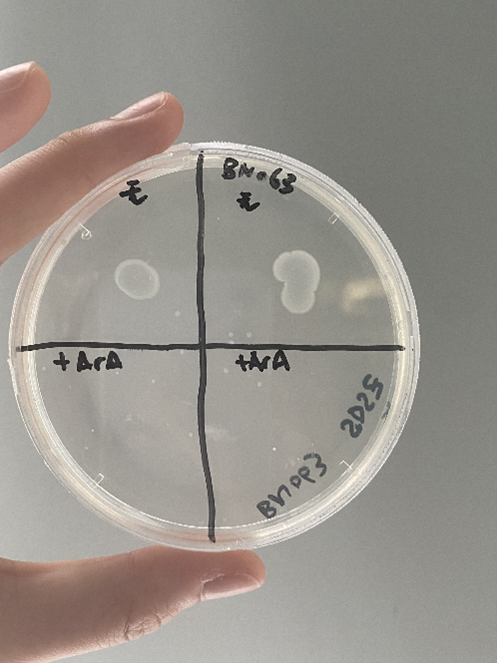Difference between revisions of "Part:BBa K4090003"
| Line 10: | Line 10: | ||
<br><br> | <br><br> | ||
After transforming the plasmids into competent BL21 cells, we inoculated the cells in eight groups, including four in liquid medium and the other four in solid medium. The results are shown in the figures below. Arabinose was added in experimental groups. We tested and calculated the mean OD value of four liquid groups. | After transforming the plasmids into competent BL21 cells, we inoculated the cells in eight groups, including four in liquid medium and the other four in solid medium. The results are shown in the figures below. Arabinose was added in experimental groups. We tested and calculated the mean OD value of four liquid groups. | ||
| − | [[File:T--SDSZ_China--Kid5.png| | + | [[File:T--SDSZ_China--Kid5.png|300px|thumb|center|Fig.2]] |
As shown in Fig.1-2, in the upper-left area of the medium, normal E.coli without the transformation of the plasmids could grow normally; in the upper-right area, transformed cells could grow normally without the presence of the Arabinose; in the bottom area, the cells were killed in the Arabinose-contained environment. Fig.1-3 shows that the OD value of liquid medium after adding Arabinose is lower than that of medium without Arabinose. These results indicate that kid toxin performed as effectively as expected. | As shown in Fig.1-2, in the upper-left area of the medium, normal E.coli without the transformation of the plasmids could grow normally; in the upper-right area, transformed cells could grow normally without the presence of the Arabinose; in the bottom area, the cells were killed in the Arabinose-contained environment. Fig.1-3 shows that the OD value of liquid medium after adding Arabinose is lower than that of medium without Arabinose. These results indicate that kid toxin performed as effectively as expected. | ||
| − | [[File:T--SDSZ_China--Kid4.png| | + | [[File:T--SDSZ_China--Kid4.png|400px|thumb|center|Fig.3]] |
<!-- --> | <!-- --> | ||
<span class='h3bb'>Sequence and Features</span> | <span class='h3bb'>Sequence and Features</span> | ||
Revision as of 18:40, 21 October 2021
Kid Toxin
Introduction
Kid toxin is a kind of toxin that E.coli produced by itself. It helps E.coli decompose the damaged organelle. However, when it is over expressed, it could kill the E.coli with high specificity. As a result, it is an useful tool in designing kill switch of E.coli.
Usage and Viability
To test the function of Kid Toxin, our team designed a part that incorporates the Arac as a promoter and Kid Toxin.
After transforming the plasmids into competent BL21 cells, we inoculated the cells in eight groups, including four in liquid medium and the other four in solid medium. The results are shown in the figures below. Arabinose was added in experimental groups. We tested and calculated the mean OD value of four liquid groups.
As shown in Fig.1-2, in the upper-left area of the medium, normal E.coli without the transformation of the plasmids could grow normally; in the upper-right area, transformed cells could grow normally without the presence of the Arabinose; in the bottom area, the cells were killed in the Arabinose-contained environment. Fig.1-3 shows that the OD value of liquid medium after adding Arabinose is lower than that of medium without Arabinose. These results indicate that kid toxin performed as effectively as expected.
Sequence and Features
- 10COMPATIBLE WITH RFC[10]
- 12COMPATIBLE WITH RFC[12]
- 21COMPATIBLE WITH RFC[21]
- 23COMPATIBLE WITH RFC[23]
- 25INCOMPATIBLE WITH RFC[25]Illegal NgoMIV site found at 160
- 1000COMPATIBLE WITH RFC[1000]
References
[1] Structural and Functional Analysis of the Kid Toxin Protein from E. coli Plasmid R1. Structure, Volume 10, Issue 10, October 2002, Pages 1425-1433.



